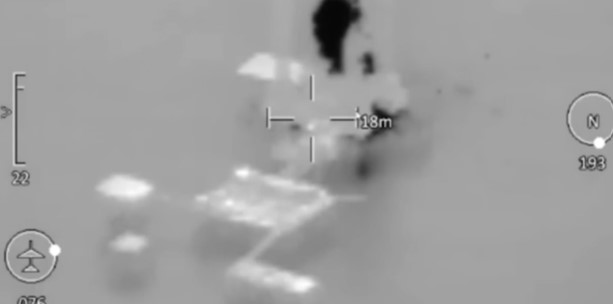Vue lecture
Valve présente le Steam Frame, son casque VR sans fil et modulaire
Roku lance la Plus Series au Canada : un téléviseur élégant et intelligent
Russian drones build self-healing relay chains using Chinese tech to hunt Ukrainian trains

Russian drones now build a web of relays and defy electronic warfare. Russia is rapidly deploying and refining remote control of long-range drones over mesh networks. In October 2025, the occupiers already used this approach to hunt Ukrainian trains, says Serhii Beskrestnov, also known as Flash, as per Defense Express.
Currently, Russian forces are building a dynamic mutual-relay network that makes drone control and communications far more resilient, even under electronic-warfare pressure.
From Chinese mesh modems to relay drones that keep functioning under fire
Flash explains that Russia turned to Chinese manufacturers to turn the idea into reality. It specially ordered mesh modems, nominally labelled as Wi-Fi gear, operating in the 1300–1500 MHz band, and uses technology that differs from conventional Wi-Fi.
Each unit costs approximately $7,000 and can deliver an output of 10–20 W per channel, allowing for links of 100 km or more.
These modems provide a digital, encrypted connection that is relatively resistant to electronic interference by using cross-frequency distribution techniques. Each modem also acts as a relay: airborne modems on drones form a chain network in which data packets automatically reroute if a node disappears.
As a result, even if many platforms are shut down, the network remains operational. The drones that survive keep the links and forward data.
“Each modem is not just a transmission point but also a relay for others. In the air, modems on drones create communications channels between themselves. Each of them tries to link to the next, and if one drops out, the information is routed around through another channel,” Beskrestnov explains.
From Gerbera to Shahed: scaling the tech for attacks on moving targets
Russia has been refining this technology for about a year. Flash noted that even if 80% of the drones are destroyed, the remainder can still relay information. Initially, Moscow tested the system on small foam drones, such as the “Gerbera", used for rear-area reconnaissance and relaying signals back toward Russian territory.
Seeing the concept’s effectiveness, the Russians began installing mesh modems on Shahed drones, enabling online control from Russian soil.
Technically, the network can provide throughput up to ~50 MB/s, and in degraded conditions, around 2 MB/s, which is enough to stream optimized high-definition video and allow FPV control with acceptable latency.
Although Shaheds are not highly maneuverable, their capabilities are sufficient to attack predictable moving targets, such as trains whose speed and route are known. An operator controlling a drone online can approach from the rear and strike a locomotive or tanker.
“These Shaheds can not only hit GPS coordinates like a substation but can also strike its most vulnerable point... We prioritize detecting these modems by their signal and jamming them with electronic warfare,” Flash says.
Modems that only switch on near the target, and ground relays on balconies
A Shahed with a mesh modem may only power the modem at a specific coordinate near the target — i.e., these modems don’t need to broadcast continuously and may activate just before strike.
Beyond airborne nodes, the Russians can set up ground relays: the modems are compact and can be installed on balconies or rooftops with internet access. Such ground nodes don’t need high antennas to communicate with nearby UAVs.
Can the system be countered?
Flash stresses that, despite the system’s complexity, it can be defeated by electronic warfare. However, the effectiveness of countermeasures depends on how widely and well Russia implements mesh technology: if Moscow deploys it not just on Shaheds but on other long-range platforms, it will gain a robust, fast, and wide two-way data channel.
Any mitigation depends on the volume, quality, and scale of Russia's deployment.
"It’s crucial not to miss the moment when Russia multiplies use of this tech across many platforms, not only Shaheds. Because that would create a resilient, fast, broad two-way data channel,” the Defense Express experts say.
The Jamaican Families Torn Apart by Hurricane Melissa

© Singeli Agnew for The New York Times
Ukraine hits Russia’s “first maritime PMC” on occupied Black Sea drilling platform near Crimea

Ukraine has turned a Russian Black Sea base into a burning metal. The Ukrainian Navy has reported that it has struck an elite Russian special forces unit stationed on the occupied Sivash drilling platform near annexed Crimea, Naval Forces of the Armed Forces of Ukraine reports.

Ukrainian drones are driving the Russians from the Black Sea towers
In October 2025, Radio Free Europe/Radio Liberty reported that Russia deployed its naval detachment “Española” to the Boiko Towers.
The group presents itself as Russia’s potential “first maritime private military company” and is reportedly seeking legal status under a future Russian law on private military companies.
According to available information, Española was created under Sergey Aksyonov, the Kremlin-appointed head of occupied Crimea, to strengthen coastal defense.
Along with Russian surveillance and reconnaissance equipment, a Russian anti-tank missile crew was destroyed,” the Ukrainian Navy reported.

Now, Russian propagandists are attempting to portray this strike as a Ukrainian loss, claiming a Ukrainian Navy boat was destroyed by a Lancet loitering munition.
In reality, Ukrainian forces successfully used a kamikaze drone to hit the occupiers' position.
Read also
-
Three Russian radars down in one night in occupied Crimea—Ukraine ramps up precision strikes on Russian air defense assets (VIDEO)
-
Pokrovsk turns gray: city becomes zone of chaos and shifting control
-
Ukraine hits Russia’s Saratov oil refinery for the seventh time — but anti-drone mesh stops a strike on key unit
OnePlus dévoile une nouvelle architecture dédiée au jeu mobile
Luc Dupont : Apple TV décroche la Formule 1
YouTube se transforme sur le téléviseur et adopte les codes de Netflix
Google crée sa première publicité entièrement générée par intelligence artificielle
Netflix envisage une offre pour acquérir Warner Bros Discovery
Quand un youtubeur ridiculise un cadenas et fait vaciller son fabricant
Netflix prépare de nouveaux essais autour de la vidéo verticale, sans rivaliser avec TikTok
Microsoft prépare une Xbox sans frontières : la console qui fusionne avec le PC
Les clés pour réussir son podcast sur YouTube, selon YouTube
AI : est-ce la fin des preuves visuelles ?
Spotify et Netflix unissent leurs forces : le vidcast s’impose
Google met à jour Veo : la génération vidéo gagne en contrôle et en réalisme
La naissance de Gambit Digital, un éditeur 100 % québécois
Netflix s’allie à Spotify pour diffuser des podcasts vidéo
Les vidéos générées par IA de célébrités décédées provoquent l’indignation de leurs familles
Les déchets de la discorde
— Permalien
Festival international du journalisme de Carleton-sur-Mer - Jour 1 - Vendredi 16 mai 2025
Webdiffusion du vendredi 16 mai 2025 - Programme: https://fijc.ca/le-programme
— Permalien
Festival international du journalisme de Carleton-sur-Mer - Jour 2 - YouTube
Webdiffusion du samedi 17 mai 2025 - Programme: https://fijc.ca/le-programme
9:45 - Informer à l’heure de la post-vérité
https://m.youtube.com/watch?v=vBUUhLz6p-0&t=660s
Brian Myles, Le Devoir
Luce Julien, Radio-Canada
Marc Gendron, Le Soleil
Marie-Eve Carignan, Université de Sherbrooke
Modération : Steven Jambot, RFI
1:40:23 - Ukraine : Le grand marchandage
https://www.youtube.com/watch?v=vBUUhLz6p-0&t=6168s
Marie-Ève Bédard, Radio-Canada
Charles-Frédérick Ouellet, photographe
Gilles Van Kote, Le Monde
Modération : Laura-Julie Perreault, La Presse
4:40:24 - LE JOURNALISME DE PÈRE EN FILS
https://www.youtube.com/watch?v=vBUUhLz6p-0&t=16824s
Grand entretien avec Patrice et Émile Roy
Entretien mené par Pénélope Garon, CIEU-FM
6:08:46 - CARTE BLANCHE À JEAN-FRANÇOIS LÉPINE
https://www.youtube.com/watch?v=vBUUhLz6p-0&t=22126s
Grand entretien avec Guy A. Lepage
— Permalien
Festival international du journalisme de Carleton-sur-Mer - Jour 3 - Dimanche 18 mai 2025 - YouTube
Webdiffusion du dimanche 18 mai 2025 - Programme: https://fijc.ca/le-programme
1:25 - Jusqu’où ira Donald Trump?
https://www.youtube.com/watch?v=5ZeFFbXmF8A&t=85s
Yves Boisvert, La Presse
Manon Globensky, Radio-Canada
Richard Latendresse, TVA, Le Journal de Montréal
Marina Catucci, Il Manifesto
Animé par Patrice Roy, Radio-Canada
1:29:34 - La presse a-t-elle encore du pouvoir?
https://www.youtube.com/watch?v=5ZeFFbXmF8A&t=5374s
Marie-Claude Lortie, Le Droit
Antoine Robitaille, Le Journal de Montréal
Pierre Sormany, journaliste-auteur
Valérie Gaudreau, Le Soleil
Modération: Lela Savic, La Converse
4:30:25 - ITINÉRAIRE D’UNE PASSIONNÉE
https://www.youtube.com/watch?v=5ZeFFbXmF8A&t=16225s
Grand entretien avec Louise Beaudoin
Rencontre menée par Jean-François Lépine
6:00:44 - Grands reportages
https://www.youtube.com/watch?v=5ZeFFbXmF8A&t=21644s
Les finalistes Annie-Claude Bisson, Alexia Boyer et Clément Hamelin du Fonds québécois en journalisme international présentent leurs projets de reportages devant public qui fera le choix final.
— Permalien